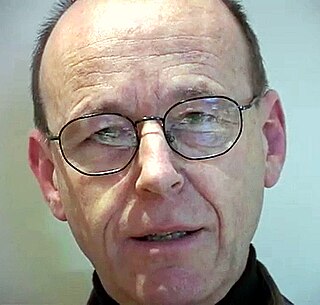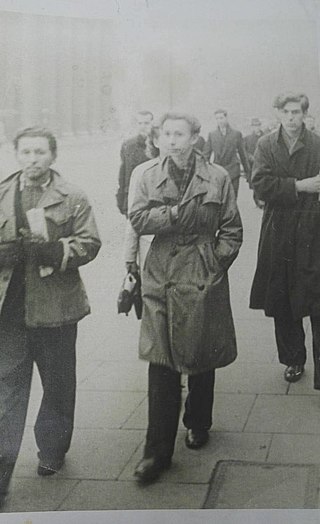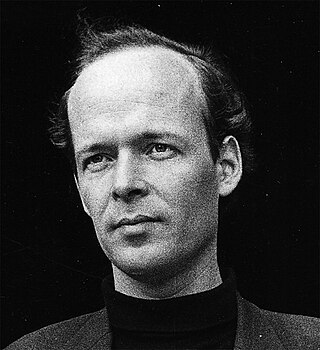Related Research Articles

Luc Tuymans is a Belgian visual artist best known for his paintings which explore people's relationship with history and confront their ability to ignore it. World War II is a recurring theme in his work. He is a key figure of the generation of European figurative painters who gained renown at a time when many believed the medium had lost its relevance due to the new digital age.

Irish art is art produced in the island of Ireland, and by artists from Ireland. The term normally includes Irish-born artists as well as expatriates settled in Ireland. Its history starts around 3200 BC with Neolithic stone carvings at the Newgrange megalithic tomb, part of the Brú na Bóinne complex which still stands today, County Meath. In early-Bronze Age Ireland there is evidence of Beaker culture and widespread metalworking. Trade-links with Britain and Northern Europe introduced La Tène culture and Celtic art to Ireland by about 300 BC, but while these styles later changed or disappeared elsewhere under Roman subjugation, Ireland was left alone to develop Celtic designs: notably Celtic crosses, spiral designs, and the intricate interlaced patterns of Celtic knotwork.
Nano Reid was an Irish painter who specialised in landscape, figure painting and portraits.
One of the finest Irish painters of the century, her rich but subtly expressionist use of pigment makes her work as relevant today as when she started painting
Matthias Weischer is a German painter living in Leipzig. He is considered to be part of the New Leipzig School.

Anthony McCall is a British-born New York based artist known for his ‘solid-light’ installations, a series that he began in 1973 with "Line Describing a Cone," in which a volumetric form composed of projected light slowly evolves in three-dimensional space.

Bryan Charnley was a British artist who had paranoid schizophrenia, and explored its effects in his work. He killed himself in July 1991.

Toko Shinoda was a Japanese artist. Shinoda is best known for her abstract sumi ink paintings and prints. Shinoda's oeuvre was predominantly executed using the traditional means and media of East Asian calligraphy, but her resulting abstract ink paintings and prints express a nuanced visual affinity with the bold black brushstrokes of mid-century abstract expressionism. In the postwar New York art world, Shinoda's works were exhibited at the prominent art galleries including the Bertha Schaefer Gallery and the Betty Parsons Gallery. Shinoda remained active all her life and in 2013, she was honored with a touring retrospective exhibition at four venues in Gifu Prefecture to celebrate her 100th birthday. Shinoda has had solo exhibitions at the Seibu Museum at Art, Tokyo in 1989, the Museum of Fine Arts, Gifu in 1992, the Singapore Art Museum in 1996, the Hara Museum of Contemporary Art in 2003, the Sogo Museum of Art in 2021, the Tokyo Opera City Art Gallery in 2022, and among many others. Shinoda's works are in the collection of the Albright-Knox Art Gallery, the Art Institute of Chicago, the British Museum, the Brooklyn Museum, the Harvard Art Museums, the Metropolitan Museum of Art, the Museum of Fine Arts, Boston, the National Museum of Modern Art, Tokyo, the Singapore Art Museum, the Smithsonian Institution, the Solomon R. Guggenheim Museum, the National Gallery of Victoria, and other leading museums of the world. Shinoda was also a prolific writer published more than 20 books.

Julian Rosefeldt is a German artist and film-maker. Rosefeldt's work consists primarily of elaborate, visually opulent film and video installations, often shown as panoramic multi-channel projections. His installations range in style from documentary to theatrical narrative.
Francis Alÿs is a Belgian-born, Mexico-based artist.
T. V. Santhosh is an Indian artist based in Mumbai. He obtained his graduate degree in painting from Santiniketan and master's degree in Sculpture from M.S. University, Baroda. Santhosh has acquired a major presence in the Indian and International art scene over the last decade with several successful shows with international galleries and museums. His earlier works tackle global issues of war and terrorism and its representation and manipulation by politics and the media. Santhosh's sculptural installation "Houndingdown" was exhibited in Frank Cohen collection ‘Passage to India’. Some of his prominent museum shows are ‘Aftershock’ at Sainsbury Centre, Contemporary Art Norwich, England in 2007 and ’Continuity and Transformation’ show promoted by Provincia di Milano, Italy. He lives and works in Mumbai.
William Henry Gerdts Jr. was an American art historian and professor of Art History at the CUNY Graduate Center. Gerdts was the author of over twenty-five books on American art. An expert in American Impressionism, he was also well known for his work on nineteenth-century American still life painting.

Dennis Creffield was a British artist with work owned by major British and worldwide art collections, including the Tate Gallery, The British Museum, Arts Council of England, the Government Art Collection, The Los Angeles County Museum of Art, Leeds City Art Gallery, University of Leeds collection, Williams College Museum of Art, University of Brighton collection, Swindon Art Gallery collection and others.
Beate Gütschow is a contemporary German artist. She lives and works in Cologne and Berlin.
Daniel Enkaoua is an artist born in France but now an Israeli citizen.
Maria Spilsbury (1776–1820) was a British artist known for her religious paintings and portraiture.

Gerhard von Graevenitz was a German kinetic artist, co-founding member of the Nouvelle Tendance and member of the op-art movement. He also belonged to the international circle of the Zero-Group. He is seen as one of the uncompromising representatives of the constructive-concrete art of the younger generation.

Richard John Spare is a British artist and Master Printmaker known primarily for his drypoints, etchings and oil paintings. He is based in London.
Kazuo Shiraga was a Japanese abstract painter and the first-generation member of the postwar artists collective Gutai Art Association (Gutai). As a Gutai member, he was a prolific, inventive, and pioneering experimentalist who tackled a range of media: in addition to painting, he worked in performance art, three-dimensional object making, conceptual art, and installations, many of which are preserved only in documentary photos and films.

Dansaekhwa, often translated as "monochrome painting" from Korean, is a retroactive term grouping together disparate artworks that were exhibited in South Korea beginning in the mid 1970s. While the wide range of artists whose work critics and art historians consider to fall under this category are often exhibited together, they were never part of an official artistic movement nor produced a manifesto. Nonetheless, their artistic practices are seen to share "a commitment to thinking more intensively about the constituent elements of mark, line, frame, surface and space around which they understood the medium of painting." Their interests compose a diverse set of formal concerns that cannot be reduced to a preference for limited color palettes.
Charles Vincent Lamb was an Irish landscape and portrait painter.
References
- ↑ James Hamilton, 'The Work of Hughie O'Donoghue', in The Irish Arts Review Yearbook, 1990-1991, p.144
- ↑ Nigel Billen, 'The History Man', in RA Magazine, Autumn 2009, issue 104
- ↑ James Hamilton, 'The Work of Hughie O'Donoghue', in The Irish Arts Review Yearbook, 1990-1991, p.144
- ↑ O'Donoghue, Hughie, (born 5 July 1953), artist. Who's Who. 2012. doi:10.1093/ww/9780199540884.013.U255843. ISBN 978-0-19-954088-4 . Retrieved 29 May 2018.
- ↑ James Hamilton, 'The Work of Hughie O'Donoghue', in The Irish Arts Review Yearbook, 1990-1991, p.152, n.9
- ↑ Air Gallery, Hughie O'Donoghue exh. cat. (London: Air Gallery, 1984)
- ↑ Hughie O'Donoghue, Hughie O'Donoghue exh. cat. (Florence: Galleria Carini and Donatini, 1987)
- ↑ Hughie O'Donoghue, Fires exh. cat. (London: Fabian Carlsson Gallery, 1989)
- ↑ Hughie O'Donoghue, 'Via crucis' exh. cat. (Munich: Haus der Kunst, 1997)
- ↑ Hughie O'Donoghue, Corp exh. cat. (Dublin: Irish Museum of Modern Art, 1998)
- ↑ Hughie O'Donoghue, Episodes from the Passion exh. cat. (Dublin: The Stationery Office, 1999)
- ↑ James Hamilton, Hughie O'Donoghue (London: Merrill, 2003)
- ↑ Hughie O'Donoghue, Parables exh. cat. (London: James Hyman Gallery, 2008).
- ↑ Hughie O'Donoghue, The Journey (Leeds: Leeds City Art Gallery, 2009)
- ↑ 'Honorary Conferrings 2005', in Alumni News (Cork: University College Cork, 2005) summer 2005
- ↑ James Hamilton, Hughie O'Donoghue (London: Merrill, 2003)
- ↑ "Irish State Visit programme". Official Royal Family website.
- ↑ Sue Hubbard, 'Hughie O'Donoghue: The Geometry of Paths', in The Independent (London newspaper), 24 March 2008
- ↑ Marianne O'Kane, 'Epic Proportions', in Irish Arts Review, vol. 20, no. 2, 1991
- ↑ Dorothy Walker, Modern Art in Ireland (Dublin: Lilliput Press, 1997) p.151
- ↑ Hughie O'Donoghue, The Geometry of Paths exh. cat. (London: James Hyman Gallery, 2008)
- ↑ Sue Hubbard, 'Hughie O'Donoghue: The Geometry of Paths', in The Independent (London newspaper), 24 March 2008
- ↑ Unsigned review, 'Hughie O'Donoghue: North Mayo retrospect' in The Irish Times (Ireland newspaper), 6 May 2011
- ↑ Hughie O'Donoghue, introduction, in Hughie O'Donoghue: Smoke Signals (London: Purdy Hicks Gallery, 2000)
- ↑ Marianne O'Kane, 'Epic Proportions', in Irish Arts Review, vol. 20, no. 2, 1991